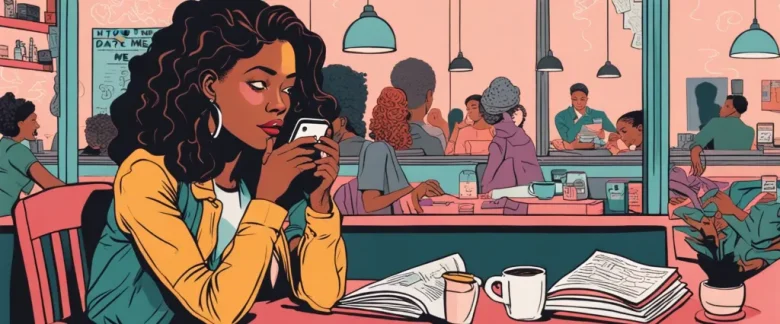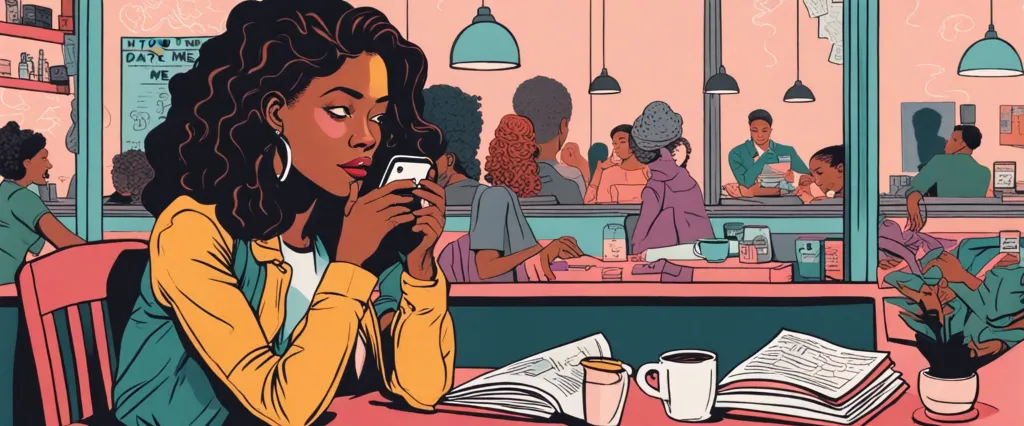In her witty and unapologetically irreverent guide, “How to Date Men When You Hate Men,” Blythe Roberson fearlessly delves into the often perplexing world of modern dating. With refreshing candor, she offers a humorous and thought-provoking exploration of dating as a feminist in a society riddled with gender dynamics and stereotypes. Roberson, a writer and comedian known for her sharp insights and satirical voice, takes readers on a journey that dismantles prevailing notions of romance, while providing astute observations and advice for those navigating the treacherous terrain of heterosexual relationships.
Chapter 1: Gender Dilemmas in Dating
Chapter 1 of “How to Date Men When You Hate Men” by Blythe Roberson introduces readers to the gender dilemmas often encountered in the dating world. Roberson begins by pointing out the societal pressures that women face when it comes to dating and relationships. She presents the idea that women are conditioned to believe that their ultimate goal should be to find a romantic partner and that their worth is often tied to their ability to attract and maintain a relationship.
Roberson discusses the inherent power imbalances in relationships, emphasizing that women are often expected to be passive and being asked to play emotional laborers, constantly monitoring men’s potential needs and desires. She challenges this dynamic and advocates for a more equitable partnership. Moreover, she addresses the idea of “pursuing” men, breaking the notion that women should be passive and wait for men to make the first move.
Additionally, the chapter touches on the concept of self-exploration and the importance of figuring out one’s wants and needs before entering a relationship. Roberson emphasizes the significance of self-worth and validates women’s feelings of anxiety and frustration in the dating process. She encourages women to embrace their independence and focus on self-love rather than feeling pressure to conform to societal norms.
Overall, Chapter 1 of “How to Date Men When You Hate Men” provides a thoughtful and humorous exploration of the complexities of gender dynamics in the dating world. Roberson aims to empower women to challenge traditional norms and take agency in their romantic lives while also shedding light on the societal pressures they face.
Chapter 2: Exploring Motivations in Dating
Chapter 2 of “How to Date Men When You Hate Men” by Blythe Roberson delves into the various motivations behind dating, particularly focusing on women’s motivations. Roberson sets out to dissect the reasons women engage in romantic relationships with men, while simultaneously exploring the underlying societal pressures and expectations that influence these motivations.
The chapter starts by addressing the fear of being alone and the persistent societal narrative that equates being single with failure. Roberson emphasizes the importance of recognizing that being in a relationship should not be the ultimate goal in life, and that personal happiness and fulfillment can be achieved outside of romantic partnerships.
She then highlights the role of heteronormative dating norms and how they shape women’s motivations. These societal expectations often push women to seek validation and self-worth through relationships with men. Roberson challenges this norm by encouraging readers to question whether these motivations are genuine or simply a response to societal pressures.
Furthermore, the author explores the concept of romance as a means to escape from reality or numb emotional pain. Roberson argues that relying on romantic relationships for escapism prevents personal growth and self-discovery.
Roberson also highlights the media’s influence on women’s motivations, with unrealistic romantic ideals perpetuated through various mediums. She pushes readers to question whether they are seeking a partner based on genuine compatibility or adhering to these idealized fantasies.
Throughout the chapter, Roberson advocates for personal introspection, urging readers to evaluate their motivations for dating men. She emphasizes the importance of cultivating relationships based on genuine connection, shared values, and self-awareness, rather than conforming to societal pressures or seeking validation from others. Ultimately, the chapter aims to empower women to challenge traditional dating norms and establish healthier, more fulfilling relationships.
Chapter 3: Building Connections with Men
Chapter 3 of “How to Date Men When You Hate Men” by Blythe Roberson focuses on the challenges and strategies involved in building connections with men. In this chapter, Roberson explores various aspects of dating, communication, and societal expectations that can hinder relationships.
Roberson starts by discussing the concept of “wife goggles” and how they impede women from seeing men as multidimensional beings. She encourages readers to approach men with open-mindedness, acknowledging that they are complex individuals with personal experiences and emotions.
The chapter delves into the common issue of miscommunication between men and women. Roberson emphasizes the importance of clearly expressing one’s feelings and needs, despite the societal norms that might discourage open communication. She also acknowledges the tendency to overanalyze texts and messages, highlighting the need to avoid making assumptions and instead ask the necessary questions to avoid misunderstandings.
Further, Roberson addresses the cultural expectations placed on men to be the initiators in romantic relationships. She challenges these traditional gender roles and invites women to take a more proactive role in pursuing connections with men, advocating for equality and shared responsibilities.
The chapter concludes with Roberson encouraging the readers to embrace vulnerability. She suggests that opening oneself up to the possibility of rejection and embracing imperfections can lead to more authentic connections. Roberson reminds readers that building connections with men is not about conforming to societal expectations but rather about mutual understanding and respect.
Overall, Chapter 3 of “How to Date Men When You Hate Men” provides insightful observations and advice on navigating the complexities of building connections with men, urging readers to approach relationships with empathy, effective communication, and a willingness to challenge traditional gender norms.
Chapter 4: Navigating Issues with Male Behavior

Chapter 4: Navigating Issues with Male Behavior of the book “How to Date Men When You Hate Men” by Blythe Roberson delves into the complexities of dealing with various behaviors exhibited by men in a dating context. With a humorous and satirical tone, Roberson navigates through issues that women commonly encounter in their relationships with men.
The chapter begins by discussing the phenomenon of “mansplaining,” where men condescendingly explain things to women without acknowledging their expertise or knowledge on the subject. Roberson humorously suggests that women should disrupt these situations by out-mansplaining men or redirecting the conversation elsewhere.
Another issue addressed is men’s inability to recognize chores or emotional labor in relationships. Roberson highlights the importance of communication in resolving these disparities and emphasizes that women shouldn’t bear the burden alone.
The chapter explores the concept of emotional intelligence and how it relates to men in dating. Roberson encourages women to be patient and understand that emotional expression might not be a strong suit for some men, while also advocating for open conversations and engagements with emotions.
The discussion then turns towards the issue of toxic masculinity and its negative impact on men and relationships. Roberson asserts that society needs to challenge traditional male gender roles and encourage vulnerability, empathy, and emotional growth.
Lastly, Roberson examines the problematic behavior of “nice guys,” who often have underlying entitlement or manipulate situations to their advantage. The author advises women to set healthy boundaries and not fall prey to their manipulative tactics.
In summary, Chapter 4 of “How to Date Men When You Hate Men” provides a comical yet insightful look at navigating various issues surrounding male behavior in dating. Roberson urges women to challenge and communicate effectively with men, while also advocating for a rethinking of traditional gender roles and toxic masculinity.
Chapter 5: Feminism in Dating
Chapter 5 of “How to Date Men When You Hate Men” by Blythe Roberson explores the intersection of feminism and dating, questioning traditional gender roles and expectations within romantic relationships. Roberson delves into the inherent power dynamics and social norms that can restrict women and advocates for a more equal and empowering approach to dating.
The chapter begins with Roberson challenging the notion that femininity requires submissiveness or the need to fulfill men’s desires. She argues that women should not have to adhere to these expectations but rather be true to their authentic selves. Roberson emphasizes that embracing feminism in dating means recognizing that women’s wants, desires, and boundaries are equally important and should be respected.
Roberson further examines the concept of emotional labor, highlighting how women are often burdened with the responsibility of emotional support and caretaking within relationships. She critiques the societal pressure for women to be nurturers and suggests the need for men to also take part in emotional labor, thus creating a more balanced and fulfilling partnership.
The chapter also addresses the issue of consent and sexual agency. Roberson emphasizes the importance of enthusiastic and continuous consent, debunking the harmful stereotype that men need to “take charge” or push boundaries without proper communication. She asserts that women have the right to express their desires and boundaries and should feel empowered to communicate their needs.
In summary, Chapter 5 of “How to Date Men When You Hate Men” challenges gender norms, promotes equality, and advocates for women to assert their desires and boundaries within romantic relationships. It calls for a shift in societal expectations to create a more empowering and satisfying dating experience for women.
Chapter 6: Exploring Gender Roles
Chapter 6 of “How to Date Men When You Hate Men” by Blythe Roberson delves into exploring gender roles in relationships. The chapter begins with the acknowledgment that men often expect a certain level of emotional labor from women, including being the emotional support and caretaker in a relationship. Roberson challenges this traditional gender role and encourages women to question whether they are willing to continue fulfilling these expectations in their relationships.
She highlights the societal pressure on women to accommodate men’s emotions while simultaneously downplaying their own. Roberson reminds readers that emotional labor should be a shared responsibility, rather than something that falls solely on women. She encourages women to prioritize their own emotional well-being and set boundaries within relationships to avoid being overwhelmed by constant emotional caretaking.
Roberson also addresses the issue of performative masculinity, wherein men often feel the need to conform to societal expectations of appearing tough and detached emotionally. She emphasizes the importance of men embracing vulnerability and breaking free from rigid gender norms, allowing for more genuine connections in relationships.
Moreover, Roberson explores the topic of gaslighting – a manipulative tactic frequently employed by men to invalidate women’s experiences or feelings. She stresses the importance of women trusting their own perceptions and speaking up against any gaslighting attempts.
In this chapter, Roberson provides a thought-provoking analysis of gender roles and encourages readers to challenge and redefine these roles in their relationships. She advocates for more equality and compassion, emphasizing the value of emotional reciprocity and asserting one’s boundaries within a partnership.
Chapter 7: Self-Discovery and Self-Love
Chapter 7 of “How to Date Men When You Hate Men” by Blythe Roberson focuses on the important journey of self-discovery and self-love. Roberson acknowledges that in order to have a fulfilling dating life, it is essential to have a strong sense of self and to prioritize self-love above all.
The chapter begins by addressing the societal pressure to constantly find a partner, as well as the fear of being alone that often leads people to settle for less than they deserve. Roberson emphasizes the importance of discovering and embracing one’s own passions, hobbies, and interests, as they are crucial aspects of developing a fulfilling personal life. By finding joy and contentment within ourselves, we can avoid relying solely on romantic relationships to feel validated or complete.
Roberson also highlights the significance of setting personal boundaries and understanding our own needs and desires. By recognizing and articulating our boundaries, we can ensure that we are treated with respect and establish healthier relationships. She also discusses the necessity of prioritizing our own self-care, including seeking therapy or engaging in other forms of personal growth that can enhance self-awareness and emotional well-being.
Furthermore, the chapter delves into the concept of self-love, emphasizing that it is not narcissism but rather an essential foundation for healthy relationships. Roberson encourages readers to practice self-compassion, accept imperfections, and challenge negative self-talk. By cultivating self-love, individuals can navigate the dating world with confidence and attract partners who truly appreciate and respect them.
In summary, Chapter 7 of “How to Date Men When You Hate Men” emphasizes the importance of self-discovery and self-love as crucial components of a fulfilling dating life. By prioritizing personal passions, setting boundaries, practicing self-care, and cultivating self-love, individuals can develop a strong sense of self and attract healthier relationships.

Chapter 8: Building Healthy Relationships with Men
Chapter 8 of “How to Date Men When You Hate Men” by Blythe Roberson delves into the exploration of building healthy relationships with men and navigating the difficulties that arise from gender dynamics and societal expectations.
Roberson begins the chapter by highlighting the inherent power imbalance between men and women in relationships, which often arises due to cultural norms. She emphasizes the importance of acknowledging this imbalance and actively working towards a more equitable partnership. Roberson encourages readers to challenge traditional gender roles, dismantle patriarchal structures, and promote open communication as a means of fostering healthier dynamics.
The chapter also delves into the topic of consent and the significance of creating a safe space for meaningful discussions surrounding personal boundaries, desires, and expectations. Roberson advocates for enthusiastic consent, where open and honest communication plays a pivotal role in establishing healthy connections.
Furthermore, the chapter explores the societal pressure placed on women to conform to societal expectations and how it affects their relationships with men. Roberson encourages readers to embrace their true selves and not compromise on their values or needs in order to maintain a relationship. She emphasizes the importance of prioritizing personal growth and self-care in order to cultivate a stronger sense of self-worth.
In summary, Chapter 8 of “How to Date Men When You Hate Men” acts as a guiding compass for building healthy relationships with men. It calls for the recognition and dismantling of patriarchal structures, the establishment of open communication and consent, and the promotion of self-care and personal growth as essential components for creating a mutually fulfilling partnership.
After Reading
In conclusion, “How to Date Men When You Hate Men” by Blythe Roberson provides an insightful and humorous take on navigating the complexities of relationships and dating in a world filled with patriarchal norms. Roberson’s blend of personal anecdotes, cultural commentary, and witty observations create a refreshing perspective on gender dynamics and societal expectations. Through her candid and often relatable experiences, she encourages readers to question and challenge traditional dating norms while advocating for self-love, independence, and setting healthy boundaries. By combining sharp humor with thought-provoking insights, Roberson leaves readers with a renewed sense of empowerment, offering guidance on how to navigate the minefield of modern dating while staying true to oneself. This book serves as a valuable guide for anyone seeking to understand and navigate the complexities of dating and relationships in a world that often feels oppressive and challenging.
1. “Men Explain Things to Me” by Rebecca Solnit – This collection of essays explores the concept of mansplaining and examines the power dynamics between men and women in society. Solnit’s insightful commentary sheds light on the challenges women face in everyday interactions and relationships.
2. “We Should All Be Feminists” by Chimamanda Ngozi Adichie – Based on her popular TED Talk, Adichie’s book is a powerful manifesto advocating for gender equality. Addressing both men and women, she skillfully dissects the societal norms and expectations that perpetuate sexism.
3. “Bad Feminist” by Roxane Gay – In this thought-provoking collection of essays, Gay delves into feminism and contemporary culture. Through personal anecdotes and sharp cultural criticism, she challenges conventional ideas of femininity and encourages readers to reconsider their own beliefs and biases.
4. “Shrill: Notes from a Loud Woman” by Lindy West – West’s memoir is a brazen and unapologetic exploration of what it means to be a woman in a society that often silences and stifles their voices. Her witty and honest writing tackles body image, reproductive rights, and the inherent sexism prevalent in the media.
5. “The Power” by Naomi Alderman – This gripping speculative fiction novel reflects on gender and power dynamics in society by imagining a world where girls and women possess a mysterious and destructive power. Alderman’s narrative is thought-provoking and challenges readers to question the role of gender in shaping society.




